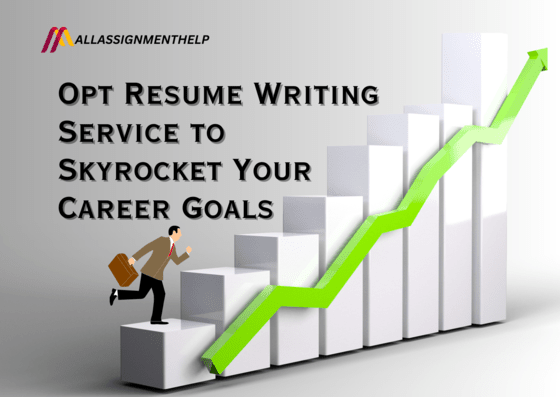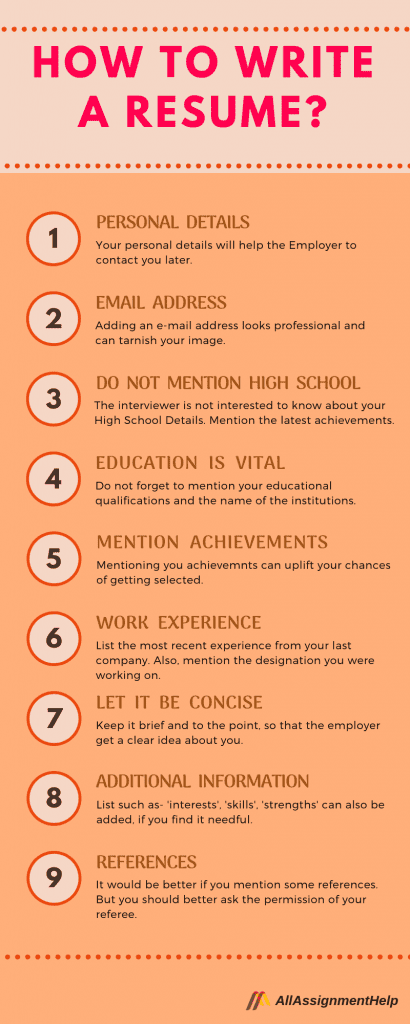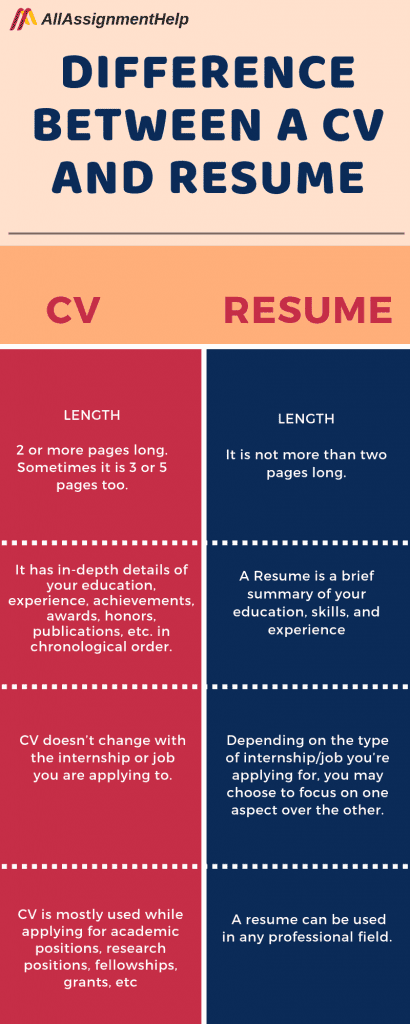Table of Contents
Hello folks! Welcome back to our blog, where we explore significant topics to help job seekers succeed. Today, we’ll talk about building an outstanding CV, which plays a vital role in job hunting. Your resume is your opportunity to leave a good first impression on prospective employers, and it has the power to make or break your probability of getting the job of your dreams. So let’s get started with the key components of making a terrific resume.
You must have heard people telling you to write a tawdry resume. Employers do notice your resume appearance. But that’s not everything. A good resume has other vital factors as well. But are you disappointed in using various methods to impress your recruiter? Probably you have not tried allassignmenthelp.com to solve your issues with your resume.
“How to write a resume which can impress employers?” Though, there could be many answers to this question. One possible answer is with the help of the Internet. There are various sites which provide free templates for resume writing. But, you cannot rely on everyone. In such cases, taking help from a professional resume-writing service becomes essential.
Seeking assistance is a good option, yet it remains equally crucial for you to grasp the fundamentals of crafting an effective resume. Allow us to guide you in comprehending the strategies behind creating a strong resume…
In this blog, You will get to know about:
- How to write a resume?
- Common resume mistakes
- Key difference between a CV and a Resume
How to Make a Resume To Get A Dream Job in 2023?
If you want to grab a recruiter’s interest and convince them to meet you, your CV must succinctly, clearly, and strategically state your qualifications. Your abilities, professional background, and assets should be communicated in a good manner.
A resume is a document through which you market yourself. It contains your education, skills and achievements etc. The key purpose of the resume is to get you an interview call. An updated resume is essential for a fruitful job search. Here are some suggestions for what to put on a resume and some dos and don’ts when writing one.
What You Should Include in your Resume?
Even though there have been significant changes for both organizations and employees over the past few years, resume trends haven’t really changed. Today, creating a CV is still the greatest strategy for getting the job you want.
Recruiters will pay immediate attention to a CV that is organized correctly and looks good. To make the text easier to read, use a clear, unified format with the right font sizes and bullet points.
Here’s how to make a resume by following trends:
-
Choose the correct format
Selection of the correct one depends on your work history. There are three main formats which are in trends i.e. Chronological resume, Combination resume and Functional resume.
A chronological resume places your professional experience at the front, following your contact information and a brief introduction. On the other hand, a functional resume (often known as a “skills-based” resume) emphasizes a candidate’s pertinent talents over their professional history and job descriptions. Last but not least, the combination resume format (often referred to as a hybrid resume) combines the key components of both a chronological and functional resume.
-
List your contact information
Your basic contact details, which you must put on your resume, are as follows:
- Name
- Email address (Use a professional email address, such as firstname.lastname@gmail.com)
- Call-in number
The following information is optional.
- A website or online portfolio (if applicable to the position)
- Your URL for LinkedIn
- Your postal address, if you want to demonstrate that you are a local.
- A succinct resume heading (subheading that sums up your experience)
We, at online assignment help can help create an impressive Resume for you. Moreover, not only having a pro-like email is a must. But you should check it daily to ensure whether you receive anything. You should have a LinkedIn profile. As much as 90% of employers use LinkedIn to search pool of talent.
-
Begin With Summary
At the top of your resume, in the introductory section, you give a brief summary of your experience, abilities, and qualifications. It can be expressed in the form of sentences or bullet points, and should not exceed three to five sentences.
-
Describe Your Work experience
The next component of your resume is the work experience section, which is the one that most recruiters and employers are looking at so it’s critical to get it properly. You should list all of your previous and current jobs in this part of the application. List the specifics of your employment in chronological order. You can also give a brief about your roles and responsibilities. Internship and volunteer experience work can also be included here.
Note: Pay close attention to the abilities listed in the job description, and if you possess any of them, be sure to provide specific examples.
Read More: Data Encryption: A Comprehensive Guide
-
Showcase your skills
It is also an important part of any resume. You can categorise your skills into two parts: Soft skills and hard skills.
Hard skills are those that you require to operate work-related equipment, they can be acquired through specialized training, workshops, work experience, or school.
You can acquire soft skills by merely engaging with people and carrying out routine tasks at work. Soft skills are correlated to your personality.
-
Educational Background
Normally, your education section comes after all of your professional experience, but if you’ve never had a full-time job or are drafting a student resume, you should put it first because you’ll need more room to discuss your academic accomplishments.
Employers are not keen to know about your high schools. Or probably accolades you’ve achieved in it. Rather employers are interested to know your recent achievements. Highlight those things which support your career goals. You may highlight your graduation achievement.
-
Mention achievements
Let’s assume you want to make a career in marketing. Mention how you increased the footfall for your college event. Or how did you persuade people to take part in activities? This will positively impact your image in front of employers. Moreover, it will create a link between your achievements and career goals.
-
Let it be concise
Keep your resume brief and to the point. It helps employers to get a clear idea about you. If you use too many adjectives for yourself, any employer will understand it’s fake. Try to highlight only relevant adjectives. Moreover, an ideal resume should be 1-2 pages. Keep sentences short and make sure your resume is easy to read.
-
Additional Information
You may like to create headings such as “Skills,” “Strengths” or “Interests” and list only relevant information in this section. Information that shows your proficiency in other languages, computer programs or other knowledge should come below this heading.
-
References
If you can, you should mention some references on your resume. A referee can be your earlier colleague or professor at your college. But before mentioning any name, take permission from that person.
So these are some main elements of any resume whether you are a fresher or an experienced job seeker. You should include all these details in your resume. At our assignment writing service platform, we keep all the above points in mind. While creating a resume for you, we watch our steps.
Common Errors People Frequently Make When Writing Resumes
There are some common mistakes which almost everyone makes. It’s important that you realize them. Otherwise, they can prove a blunder for you. With years of experience, our resume experts know how to overcome such mistakes. Resume writing service experts have ears to the ground. They carefully analyse your needs, and then start working on your resume. So, I am glad to share a few things with you.
Here I am providing a list of the common mistakes made while writing a resume:
1. The name of the resume file is not proper
Some of you name your resume file as resume.doc or cv.doc. Or something similar. This is an unprofessional way of naming your file. It also becomes difficult for employers to identify your resume. Employers have a collection of data on many people. Just wonder if employers have hundreds of resumes with the same file name. In such cases, “How would he identify your resume, in case he may need to contact you.”
It will be nearly impossible to check and identify your resume.
The correct way of naming your resume file is first name last name – CollegeName.doc. Moreover, you should save your resume in PDF format. It looks very professional.
2. The resume runs into more than 2 pages
There is no hard and fast rule that your resume should be 1 page and max it can go up to 2 pages. But it’s a common habit that most of resume runs into more than 2 pages. It is because either it contains too many irrelevant details or because space has not been utilized properly.
Your resume should not be longer than two pages. It is the ideal length for an ideal resume.
Read More: Data Communication: A Connectivity Method between Two Entities
3. Resume follows a 2-column structure
Often, many among you make the resume in a 2 column structure. But that’s not the way it should be. Stick to only one column structure. Two-column structure makes the reading extremely difficult. It is because the reader gets confused about which column should focus on.
If you are getting confused about this, you can opt for a resume-writing service.
4. Your resume contains the logo of your college
There are few colleges where Placement cells make it necessary that you put your logo on top of your resume. In such a case, you cannot help it but put the logo. But keep it on the top of your resume. However, otherwise, if you are applying for off-campus jobs and do not include the logo
As this makes the appearance of the resume bulky. Your resume is your advertisement, not your college’s. Delete the logo, if you have it on your resume.
5. Your resume contains your photograph
This is again not compulsory. If you have it in your present resume, please remove it. There is absolutely no need for a photo in your resume. However, for some jobs, your looks matter. For example, industries such as aviation, hospitality, media, firms, etc.
Also, it is quite an outdated practice.
6. Your resume contains a very generic Career Objective Statement
Most often, people copy-paste. But, you must have a Career Objective of your own and not a copied one, like below.
“To face the challenges of a working engineer in a competitive environment of industry. This, in turn, enables me to extract the best out of me which is conducive to learning and growing as a professional. As a result of which directing my future endeavors as an asset to the organization.”
Such kind of copy-pasted will serve you nothing. These kinds of statements show that you have no idea of what you want from your career.
You should have a very specific career objective statement. Or rather, you can have no statement at all. Weird? Seems like, but that’s ok as it’s better than presenting a copied one.
7. You have mentioned each year’s/semester’s GPA/% Marks in your academics section
Not at all required. Just mentioning aggregate marks/CGPA is enough. For example, if you have completed six years of a B.Tech degree, you don’t have to write each semester’s GPA. Only an aggregate CGPA is enough.
8. You have listed all the courses and labs that you have done to date
Again, not required. If you have it in your resume, please brush it aside. At best list 2-3 most relevant courses along with your grades in that course (if grades were good).
If an employee wants to know all the courses that you have done to date, probably he will ask for a transcript for each course.
Difference between a CV and a Resume
It’s confusing, but still, we can draw a line between the two. Both terms are used interchangeably.
- The principal difference between the two is their length. A CV (stands for Curriculum Vitae, which means a course of life in Latin) is 2 or more pages (generally 3-5 pages) long. CV is a document which has in-depth details of your education, experience, achievements, awards, honours, publications, etc. in chronological order.
- CV doesn’t change with the internship or job you are applying to.
- On the contrary, a resume is a brief summary of your education, skills, and experience. It is not more than two pages long. Depending on the type of internship/job you’re applying for, you may choose to focus on one aspect over the other.
Apparently, a CV is mostly used while applying for academic positions, research positions, fellowships, grants, etc. On the contrary, the resume is used everywhere else. Mostly, most of you write a blend of CV and Resume.
Target the reader with the CV
Your resume builds your identity. It’s crucial to consider who will read your CV when you’re writing it. Is it a trade group looking for speakers or for journal articles to publish? If you are applying for a leadership or research position at a top university, is there a hiring committee there?
Determine who you are attempting to impress and take steps to establish yourself as a highly qualified expert and leader. A doctor might have a slightly different emphasis in each CV—a version for patients, another for coworkers, one for landing a keynote speech or Ted talk, and another for applying for a leadership or academic position—to further highlight this distinction.
Get Your Updated Resume From Our Resume writing service
You probably have understood much about a resume. But still knowing this much, you are not qualified to write a good resume. Simply, because you’re a novice at it. In contrast, resume experts provide you with the perfect help as they hold years of experience in the field. This is the main reason that when you get stuck, why you should opt for a resume-writing service.
However, even if you try to write a resume, your written resume may not be that impressive. Consequently, it would impact your image negatively. It is because you don’t know what employers want to read or you’re just taking a guess.
If you haven’t had an impressive resume and it is affecting your job chances, then you should definitely approach some good professional business development writing service.
Who we are and what we do
Welcome to our outstanding staff! Our multifaceted team of professionals, each with a focus on a different area, is something we are proud of. We have helped a lot of students throughout the years to complete assignments, dissertations, theses, and other academic obstacles. Our knowledge goes beyond academia, though. Whether you need assistance with an online assignment or with creating a strong CV, resume, or cover letter, we can help.
Our team is committed to providing the greatest support and ensuring your success in every business venture and endeavour relating to your studies. While other providers are busy making money. They zig when one should zag. For some, it has become a habit to grab money from students and provide them with low-quality content. However, we cannot polish such turds.
Have a doubt? You may contact us through our website. However, we can help you with your online courses as well. You can ask our expert to take my online course for me and you will get instant help with your requirements.
Thanks for Reading!
FAQs
| What resume-writing format is the most effective? It is usually a safe choice to stick with standard formatting: white page, black text, readable font, even when visual or infographic resumes have grown popular in several areas. |
| Can you Provide me help with resume writing along with assignment writing? Yes, we also offer assistance with writing resumes. For both, you must make separate payments. |


